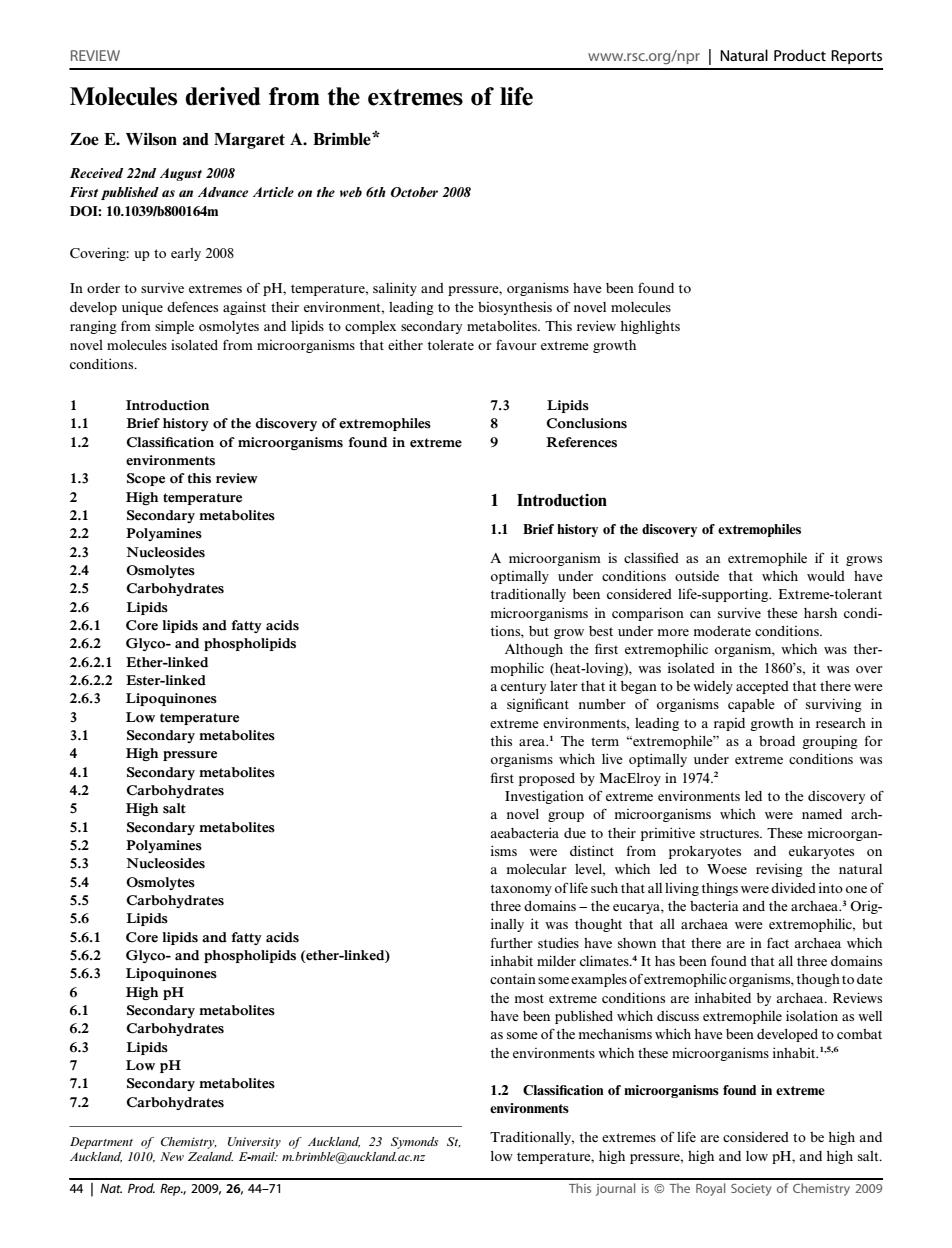正在加载图片...

REVIEW www.rsc.org/npr|Natural Product Reports Molecules derived from the extremes of life Zoe E.Wilson and Margaret A.Brimble* Received 22nd August 2008 First published as an Advance Article on the weh 6th October 2008 D0:10.1039/b800164m Covering:up to early 2008 In order to survive extremes of pH.temperature.salinity and pressure.organisms have been found to develop unique defences against their environment,leading to the biosynthesis of novel molecules conditions Introduction 7.3 Lipids Brief history of the discovery of extremophiles Conclusions onof microorganisms found in extreme References Scope of this review High temperature 1 Introduction 2.3 Polyamin etab lites 1.1 Brief history of the discovery of extremophiles Nucleosides ydrate 26 Linids traditionally been considered life-supporting.Extreme-tolerant 261 Core lipids and fatty acids inke phosph olipid Although the first extremophilic organism.which was ther 3631 2.6.2.2 Ester-linked mophilic (heat-loving).was isolated in the 1860's.it was over 2.6.3 Lipoquinone extreme environments,leading to a rapid growth in research in 3.1 4 High pressure High salt group of whic e named arch Secondary metabolites 53 54 Osmolytes a molecular level,which led to Woese revising the natural axon 5 Carbohydrates inally it was thought that all archaea were extremophilic.bu 561 5.6.2 Glyco-and phospholipids (ether-linked) have shown that therere n which n hat all three 5.6.3 ugh to date 6.1 the most extreme conditions are inhabited by archaca.Review Carbohydrates have been published which discuss extremophile isol Lipids 7.1 Secondary metabolites 7.2 Carbohydrates 1.2 Classification of microorganisms found in extreme Traditionally,the extremes of life are considered to be high and low temperature.high pressure,high and low pH.and high salt. 441 Nat.Prod..Rep,2009,26,44-7刀 This journal isThe Royal Society of Chemistry 2009 Molecules derived from the extremes of life Zoe E. Wilson and Margaret A. Brimble* Received 22nd August 2008 First published as an Advance Article on the web 6th October 2008 DOI: 10.1039/b800164m Covering: up to early 2008 In order to survive extremes of pH, temperature, salinity and pressure, organisms have been found to develop unique defences against their environment, leading to the biosynthesis of novel molecules ranging from simple osmolytes and lipids to complex secondary metabolites. This review highlights novel molecules isolated from microorganisms that either tolerate or favour extreme growth conditions. 1 Introduction 1.1 Brief history of the discovery of extremophiles 1.2 Classification of microorganisms found in extreme environments 1.3 Scope of this review 2 High temperature 2.1 Secondary metabolites 2.2 Polyamines 2.3 Nucleosides 2.4 Osmolytes 2.5 Carbohydrates 2.6 Lipids 2.6.1 Core lipids and fatty acids 2.6.2 Glyco- and phospholipids 2.6.2.1 Ether-linked 2.6.2.2 Ester-linked 2.6.3 Lipoquinones 3 Low temperature 3.1 Secondary metabolites 4 High pressure 4.1 Secondary metabolites 4.2 Carbohydrates 5 High salt 5.1 Secondary metabolites 5.2 Polyamines 5.3 Nucleosides 5.4 Osmolytes 5.5 Carbohydrates 5.6 Lipids 5.6.1 Core lipids and fatty acids 5.6.2 Glyco- and phospholipids (ether-linked) 5.6.3 Lipoquinones 6 High pH 6.1 Secondary metabolites 6.2 Carbohydrates 6.3 Lipids 7 Low pH 7.1 Secondary metabolites 7.2 Carbohydrates 7.3 Lipids 8 Conclusions 9 References 1 Introduction 1.1 Brief history of the discovery of extremophiles A microorganism is classified as an extremophile if it grows optimally under conditions outside that which would have traditionally been considered life-supporting. Extreme-tolerant microorganisms in comparison can survive these harsh conditions, but grow best under more moderate conditions. Although the first extremophilic organism, which was thermophilic (heat-loving), was isolated in the 1860’s, it was over a century later that it began to be widely accepted that there were a significant number of organisms capable of surviving in extreme environments, leading to a rapid growth in research in this area.1 The term ‘‘extremophile’’ as a broad grouping for organisms which live optimally under extreme conditions was first proposed by MacElroy in 1974.2 Investigation of extreme environments led to the discovery of a novel group of microorganisms which were named archaeabacteria due to their primitive structures. These microorganisms were distinct from prokaryotes and eukaryotes on a molecular level, which led to Woese revising the natural taxonomy of life such that all living things were divided into one of three domains – the eucarya, the bacteria and the archaea.3 Originally it was thought that all archaea were extremophilic, but further studies have shown that there are in fact archaea which inhabit milder climates.4 It has been found that all three domains contain some examples of extremophilic organisms, though to date the most extreme conditions are inhabited by archaea. Reviews have been published which discuss extremophile isolation as well as some of the mechanisms which have been developed to combat the environments which these microorganisms inhabit.1,5,6 1.2 Classification of microorganisms found in extreme environments Traditionally, the extremes of life are considered to be high and low temperature, high pressure, high and low pH, and high salt. Department of Chemistry, University of Auckland, 23 Symonds St, Auckland, 1010, New Zealand. E-mail: m.brimble@auckland.ac.nz 44 | Nat. Prod. Rep., 2009, 26, 44–71 This journal is ª The Royal Society of Chemistry 2009 REVIEW www.rsc.org/npr | Natural Product Reports